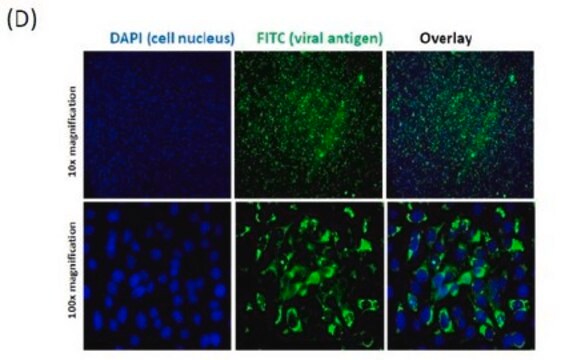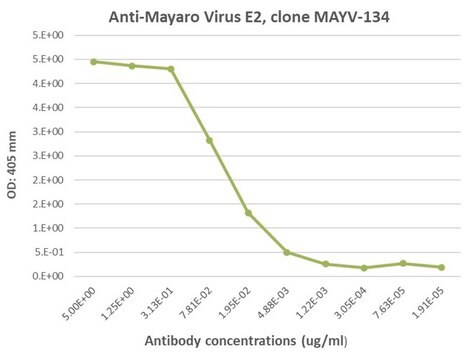MABF2733
Anti-Chikungunya virus E2 Antibody, clone CHK-152
About This Item
Prodotti consigliati
Origine biologica
mouse
Livello qualitativo
Coniugato
unconjugated
Forma dell’anticorpo
purified antibody
Tipo di anticorpo
primary antibodies
Clone
CHK-152, monoclonal
PM
calculated mol wt 138.07 kDa
Purificato mediante
using protein G
Reattività contro le specie
virus
Confezionamento
antibody small pack of 100 μL
tecniche
ELISA: suitable
inhibition assay: suitable
neutralization: suitable
Isotipo
IgG2κ
Sequenza dell’epitopo
Unknown
N° accesso UniProt
Condizioni di spedizione
dry ice
modifica post-traduzionali bersaglio
unmodified
Descrizione generale
Specificità
Immunogeno
Applicazioni
Evaluated by ELISA with recombinant Chikungunya Virus E2 Envelope Protein.
ELISA Analysis: Various dilutions of this antibody detected recombinant Chikungunya virus E2 protein.
Tested Applications
Surface plasmon resonance: A representative lot detected Chikungunya virus E2 in Surface plasmon resonance applications (Pal, P., et al. (2013). PLoS Pathog. 9(4):e1003312).
Neutralizing Analysis: A representative lot neutralized CHIKV and protected immunocompromised mice against disease. (Pal, P., et al. (2013). PLoS Pathog. 9(4):e1003312).
ELISA Analysis: A representative lot detected Chikungunya virus E2 in ELISA applications (Zhang, R., et al. (2019). Cell Rep. 28(10):2647-2658.e5).
Inhibition Analysis: A representative lot inhibited CHIKV infection when added after virus adsorption to cell surface. (Pal, P., et al. (2013). PLoS Pathog. 9(4):e1003312).
Note: Actual optimal working dilutions must be determined by end user as specimens, and experimental conditions may vary with the end user
Stato fisico
Stoccaggio e stabilità
Altre note
Esclusione di responsabilità
Non trovi il prodotto giusto?
Prova il nostro Motore di ricerca dei prodotti.
Codice della classe di stoccaggio
12 - Non Combustible Liquids
Classe di pericolosità dell'acqua (WGK)
WGK 2
Punto d’infiammabilità (°F)
Not applicable
Punto d’infiammabilità (°C)
Not applicable
Certificati d'analisi (COA)
Cerca il Certificati d'analisi (COA) digitando il numero di lotto/batch corrispondente. I numeri di lotto o di batch sono stampati sull'etichetta dei prodotti dopo la parola ‘Lotto’ o ‘Batch’.
Possiedi già questo prodotto?
I documenti relativi ai prodotti acquistati recentemente sono disponibili nell’Archivio dei documenti.
Il team dei nostri ricercatori vanta grande esperienza in tutte le aree della ricerca quali Life Science, scienza dei materiali, sintesi chimica, cromatografia, discipline analitiche, ecc..
Contatta l'Assistenza Tecnica.








